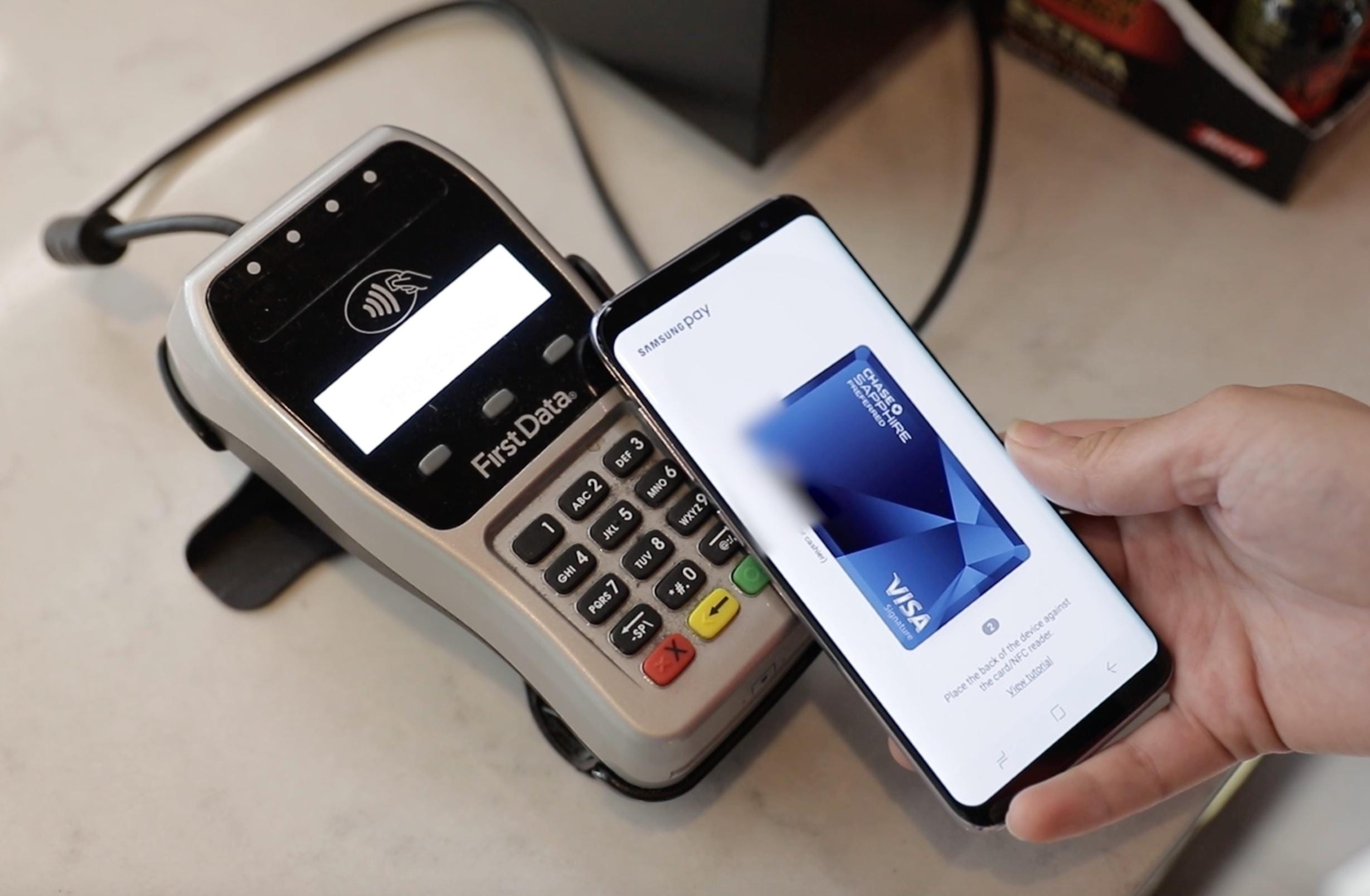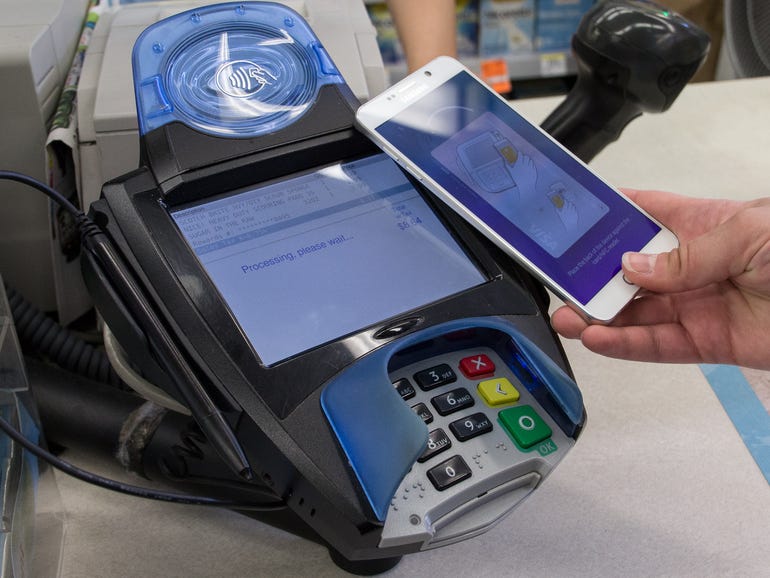
Samsung Pay makes it easy to pay with your phone at places you'd normally use a physical credit or debit card. Just tap your phone or watch to make a contactless payment and away you go. Samsung Pay offers one major feature that rivals like Apple Pay and Google Pay lack. Called MST, or magnetic secure transmission, Samsung Pay works almost anywhere you pay for things -- even at older terminals that haven't been updated to work with contactless payments. But MST is being phased out in the US in 2021, starting with the Galaxy S21 phones, which makes Samsung Pay less of an essential choice on Android. Read on for everything you need to know about Samsung Pay.
Samsung Pay is available in 29 countries worldwide
Deep breath: the US, UK, Australia, Belarus, Brazil, Canada, China, France, Germany, Hong Kong, India, Indonesia, Italy, Kazakhstan, Kuwait, Malaysia, Mexico, Puerto Rico, Russia, Singapore, South Africa, South Korea, Spain, Sweden, Switzerland, Taiwan, Thailand, United Arab Emirates and Vietnam.
Which phone, bank, card and carrier do I need?
Samsung Pay works with Galaxy phones, from the latest Galaxy S21 Ultra all the way back to the Galaxy Note 5 ($149 at Walmart) from 2015. It's also available on some smartwatches including the Galaxy Watch 3, Galaxy Watch Active ($170 at Amazon) 2, Gear S2 ($160 at Amazon) (only for transactions on NFC terminals), Gear S3 and Gear Sport.
All major carriers in the US support Samsung Pay: AT&T, Cricket, MetroPCS, Sprint, T-Mobile, Verizon and US Cellular. You will also need a Visa, MasterCard, Discover or American Express card. See the full list of supported banks and cards in the chart below.
Samsung Pay users can also apply for a debit card called Samsung Money, in partnership with personal finance company SoFi.
Read more: I used to love Samsung Pay. But now I switched and haven't looked back
Where can I use Samsung Pay?
Samsung claims that its system will work with almost all point-of-sale systems: NFC, magnetic stripe and EMV (Europay, MasterCard and Visa) terminals for chip-based cards. It generally won't work with readers where you need to physically insert your card into a slot, such as those found at gas stations or on ATMs.
Using Samsung Pay in stores around San Francisco, I found that it was accepted almost everywhere. These included vendors using Square readers; NFC terminals in major chain retailers like Trader Joe's and Walgreens; and magnetic stripe readers in smaller stores. You may still need to sign a receipt for the transaction.
Samsung Pay also works on various public transit systems around the world, including MTA's OMNY system in New York City and Portland's TriMet. You can also use Samsung Pay within certain Samsung apps to make purchases without having to type in credit card details.
How do I set up Samsung Pay?
Once the Samsung Pay app is installed, sign in with your Samsung account if you haven't already. The app will prompt you to register a PIN, fingerprint or iris scan if you don't have one set up. You can now add a credit, debit, gift or membership card by scanning it with the camera. You'll also have the option to add your PayPal account as well.
Check that the number, name and expiration date from the scanned cards are all correct. Samsung Pay will verify a credit or debit card with your bank and you'll have the option to get an SMS, email or make a phone call to confirm.
A total of 10 cards can be added to Samsung Pay.
How does Samsung Pay work?
Samsung Pay uses two technologies that allow it to work almost anywhere. The first is near-field communication (NFC) for tap-to-pay transactions at contactless terminals. The second is magnetic secure transmission (MST) for older terminals where you would normally swipe a card. The phone emits a magnetic signal to simulate the magnetic strip found on the back of a credit or debit card when you hold the phone against one of these readers.
In 2015 Samsung acquired mobile payment company LoopPay, which developed the specific MST technology used for Samsung Pay.
However, starting with the Galaxy S21, new Galaxy phones released in the US will no longer support MST. "Due to the rapid adoption of near field communication (NFC) technology by consumers and businesses, beginning with devices launched in 2021, Samsung Pay will focus its support on NFC transactions, across the Galaxy portfolio. While future devices will no longer include magnetic stripe technology (MST), customers with previous, compatible Galaxy devices will be able to continue using Samsung Pay, including MST," Samsung said in a statement to CNET.
Owners of phones released in 2020 and earlier, such as the S20 FE, Note 20 Ultra and Z Fold 2, will still support MST in Samsung Pay.

Samsung Pay works on older Galaxy phones like the Note 5.
Lexy Savvides/CNETHow do I make a payment with Samsung Pay?
From the lock screen, swipe up from the small Samsung Pay bar. Select the card you want to pay with, then place your finger on the fingerprint scanner to verify, use the iris scan or enter your PIN. Tap the back of the phone against the payment terminal.

You'll see a transaction notification pop up at the top of the screen.
Lexy Savvides/CNETIf you're using a debit card through Samsung Pay, you may still need to enter the card PIN on the terminal. Once the payment is made you'll get a notification that confirms the merchant name and the amount. It's also listed in the Samsung Pay app.
From a watch, press and hold the appropriate button to launch Samsung Pay, then tap the watch against the terminal.
How does Samsung Pay differ from Apple Pay or Google Pay?
The main difference is that Samsung Pay works at almost all stores that accept credit or debit cards, not just those with tap-to-pay NFC terminals (as long as you own a Galaxy phone released before 2021 in the US). Samsung Pay also offers a cash back feature, promotions including bonus Samsung account points and vouchers with a number of participating retailers. Chase Pay users can link their existing digital wallet with Samsung Pay.
Apple Pay and Google Pay let you pay friends and family through Apple Cash over iMessage, and Google Pay over Gmail, messages or the Google Assistant. Samsung Pay also lets you make peer-to-peer payments. However, you will need to sign up for a prepaid debit card called Samsung Pay Cash and your friends or family will also need to have a Samsung Pay Cash account to receive money.
As of January 2021, Samsung no longer gives users Samsung Rewards points for every purchase, but transactions made at Samsung.com, the Galaxy Store and other Samsung purchases will still earn points.
Samsung Pay vs. Apple Pay vs. Google Pay
| Samsung Pay | Apple Pay | Google Pay | |
| Compatible devices | Samsung Galaxy phones since the Galaxy Note 5, Gear Watch and Gear Watch Active, Gear S2 and S3 | Apple iPhones since the SE, Apple Watch, MacBook Pro with TouchID, iPads since 5th generation, iPad Pro and iPad Mini | Android phones with NFC and HCE support running KitKat (4.4) or higher |
| Availability (see note below) | 29 countries worldwide | 60 countries worldwide | 40 countries worldwide |
| Authentication | Fingerprint, PIN or iris | FaceID or fingerprint | Fingerprint, PIN, pattern or password |
| Where can you use? | Works with NFC, magnetic stripe or EMV terminals, in-app purchases | Works with NFC terminals, in-app purchases and web purchases in Safari | Works with NFC terminals and in-app purchases |
| Cards | Credit, debit, loyalty and gift cards | Credit, debit and loyalty cards | Credit, debit, loyalty and gift cards |
| Which banks? | Wide variety of banks: full list here; PayPal | Wide variety of banks: full list here | Wide variety of banks: full list here; PayPal |
Is Samsung Pay secure?
Samsung Pay does not store the account or credit card numbers of cards on the device, instead using tokenization for transactions. Each time a purchase is made, the phone sends two pieces of data to the payment terminal: the first is a 16-digit token that represents the credit or debit card number, while the second is a one-time code or cryptogram generated by the phone's encryption key.
What if I lose my phone or my plastic card?
Payments can't be made from your phone without being authorized via fingerprint, PIN or iris scan. If you register with Samsung's Find My Mobile service you can remotely erase information on the phone, including any cards stored in Samsung Pay.
If you lose your physical credit or debit card, once you've contacted your bank to cancel it, you won't be able to use it for a period of time within Samsung Pay. But the app should automatically generate a new account number when your bank issues a new card.
Also, your digital card information will automatically update when you get a new card issued, such as when you're nearing the expiry date.
Can I use Samsung Pay even without a data connection?
Yes, although you will only be able to make 10 payments without the device being on Wi-Fi or cellular data. You will also need an active internet connection to add a card and to access transaction history.
What about when I travel overseas?
For US customers, if you can use your card overseas then it's likely it will also work with Samsung Pay when you travel. The caveat is that if you try to add a card while you are traveling outside the US, you may have to contact your bank.
Does Samsung Pay also work for returns?
Yes. You may need you to hold the phone against the payment terminal in the same way as when you made the payment to process the return. Also, you may be asked to match the payment information on the receipt with the last four digits of your virtual card number, which you can find in the Samsung Pay app.
"need" - Google News
July 21, 2021 at 05:00PM
https://ift.tt/2TsJI8I
Samsung Pay FAQ: Everything you need to know - CNET
"need" - Google News
https://ift.tt/3c23wne
https://ift.tt/2YsHiXz
Bagikan Berita Ini
















0 Response to "Samsung Pay FAQ: Everything you need to know - CNET"
Post a Comment